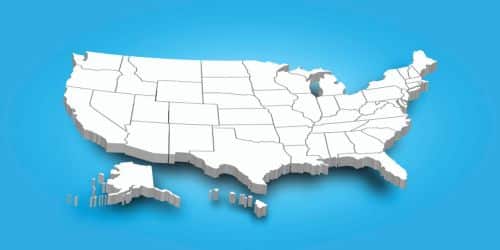Are you looking for an affordable location to live? The good news is that, even in this economy, you have plenty of options.
Only a few states, such as New York and California, have housing expenses that match or exceed the overall cost of living in the cheapest places. There are numerous enticing urban regions in states with lower living costs.
All of the cheapest states to live in 2023 on the list below provide a wealth of options as well as a low cost of living, making them ideal for anyone wishing to save money without sacrificing quality of life.
Perhaps you’re looking for a new house, planning a company, or wondering where you can afford to retire. In any event, this list of the cheapest states to live in 2023 will get you off on the right foot.
The Cost of Living Index
At 100, the Cost of Living Index estimates the average cost of living. Every state with a cost of living average of less than 100 is regarded to be below the national average.
The cost of living in states with populations greater than 100 is higher than the national average.
The typical cost of living includes food, shelter, clothing, utilities, transportation, healthcare, public education, and taxes.
According to MIT, the average cost of living for two working adults in a family of four is $16.54 per hour or $68,808 per year.
The minimum wage of $7.25 per hour places families in poverty.
Smaller cities and villages can nevertheless provide a great education, healthcare, and community spirit, as well as an improvement in your standard of living.
Less traffic, cleaner air, less expensive housing, and even lower taxes in some states are all appealing.
Living in a state with a lower living wage means that more of your income is accessible for investment. This will allow you to obtain more financial freedom and peace of mind over time. You may also keep your cv up to date by using a free cv template to obtain work in these states.
10 Cheapest States To Live In the US for 2023
#1. Mississippi
- Cost of Living Index: 83.3
- Groceries: 92.2
- Housing: 66.3
- Utilities: 90.4
- Transportation: 86.7
- Health: 94.7
- Miscellaneous: 90.9
Mississippi is the cheapest state in the United States to live in. Overall, the state’s costs are 17% cheaper than the national average. Mississippi has the lowest housing costs in the country. In Mississippi, the median price for a single-family home is $157,828, and the average rent for a two-bedroom apartment is $991. Mississippi also boasts the nation’s lowest transportation expenses.
Despite the low cost of living, Mississippi has the highest poverty rate in the US, with approximately one-fifth of the population living at or below the poverty line. Mississippi has routinely regarded as one of the worst states to live in, owing mostly to economic and educational issues. To meet their demands, a family of four requires a yearly income of $75,462.40. Meanwhile, the median family income is $44,966.
#2. Kansas
- Cost of living index: 86.5
- Groceries: 91.7
- Housing: 72.6
- Utilities: 1000.2
- Transportation: 97.3
- Health: 1000.4
- Miscellaneous: 88.4
Kansas has the second-cheapest cost of living in the country. It has the third-lowest housing costs in the US, at 28% less than the national average. In Kansas, the average single-family home costs $198,199. A two-bedroom apartment rents for $995 per month on average.
Groceries and transportation are likewise less expensive than the national average.
For a family of four, the annual living wage in Kansas is $76,252.80. A family of four has a median income of $72,815. Kansas has a somewhat lower poverty rate than the national average and, at 2.5%, one of the lowest unemployment rates in the country.
#3. Alabama
- Cost of Living Index: 87.9
- Groceries: 98.2
- Housing: 70.1
- Utilities: 100.7
- Transportation: 92.7
- Health: 91.2
- Miscellaneous: 94.3
With a cost of living index of 87.9, Alabama is the third cheapest state to live in the United States. Housing in the state is reasonably priced. In Alabama, the average single-family home sells for $194,695. A two-bedroom apartment in California costs an average of $1,005. While electricity and food are closer to the national average, Alabama has some of the lowest health and transportation expenditures in the country.
In Alabama, a family of four requires an annual salary of $77,064 to cover their expenses. A family of four earns $54,393 per year on average. With 15.6% of residents living at or below the poverty level, Alabama has one of the highest poverty rates in the country.
#4. Oklahoma
- Cost of Living Index: 87.9
- Groceries: 94.5
- Housing: 74.7
- Utilities: 95.1
- Transportation: 94.8
- Health: 94.5
- Miscellaneous: 92.6
Oklahoma is the fourth cheapest state to live in the United States, with a cost of living index of 87.9. The state has the fourth cheapest house prices in the country, 25% lower than the national average. The average house costs $171,057. The average monthly rent is $999. Groceries and healthcare are also among the cheapest in the country.
In Oklahoma, the median annual income for a household of four is $52,341. The livable wage for a family of four, on the other hand, is $77,126.40. Because of this inequality, Oklahoma has one of the highest rates of poverty in the country. 15% of the population lives at or below the poverty line. The poverty rate among youngsters is around 20%. Oklahoma has also routinely ranked as one of the worst states in which to live in the US.
#5. Georgia
- Cost of Living Index: 88.8
- Groceries: 95.9
- Housing: 74.4
- Utilities: 90.5
- Transportation: 92.6
- Health: 96.7
- Miscellaneous: 97.1
Georgia is the sixth cheapest state in the country. The state has the fourth lowest housing costs in the country, with costs that are 25% cheaper than the national average. Housing affordability is among the best in the country, with more than 40% of inhabitants able to purchase a new home. Georgia also has some of the lowest transportation prices in the country. The average monthly utility bill is $367.63.
Despite having the nation’s lowest minimum wage, at $5.15 per hour, earnings in the state are often sufficient to pay living expenses. In Georgia, the median annual income for a family of four is $58,952, while the cost of living is $79,955.20.
#6. Tennessee
- Cost of Living Index: 89.0
- Groceries: 94.7
- Housing: 79.3
- Utilities: 92.5
- Transportation: 88.8
- Health: 91.2
- Miscellaneous: 94.2
Tennessee is the sixth-cheapest state in America. The state has a lower overall cost of living than the national average by 11%. The average cost of housing in the state is 21% lower than the national average, with a typical single-family home costing $276,963 and a typical two-bedroom apartment renting for $1,138 per month. Tennessee also has the nation’s second-lowest transportation costs and the fifth-lowest healthcare costs. An average household’s monthly utility bill is $256.83.
In Tennessee, the annual living wage for a family of four is $74,692.80. The same family’s median income is $54,665. The state’s unemployment rate is 3.4%, but the poverty rate is 13.8%.
#7. Missouri
- Cost of Living Index: 89.8
- Groceries: 95.0
- Housing: 80.3
- Utilities: 95.4
- Transportation: 92.4
- Health: 94.6
- Miscellaneous: 93.3
With a cost of living index of 89.8, Missouri is the seventh-cheapest state in the country. Missouri’s housing costs 20% less than the national average. A typical single-family home in the state costs $218,208, and a two-bedroom apartment costs $963 a month on average. The average monthly utility bill is $363.80. Missouri’s cost of living index is lower than the national average in all categories, with particularly low costs for health and transportation.
In Missouri, the annual living wage for a family of four is $77,792, while the median income is $61,901. Missouri has one of the highest minimum wages in the US, at $11.15 per hour.
#8. Iowa
- Cost of Living Index: 89.9
- Groceries: 98.4
- Housing: 76.0
- Utilities: 94.9
- Transportation: 97.7
- Health: 94.6
- 93.3 Miscellaneous
Iowa is the eighth-cheapest state in the US to live in. Across the board, Iowa’s costs are lower than the national average. Iowa has the sixth-lowest housing index in the country, with a score of 76. A typical single-family home costs $183,418 on average, while a two-bedroom apartment costs $895 on average. Utilities cost the average family $336.24 per month.
The typical income in Iowa for a family of four is $68,469, which is less than the $76,440 needed to fulfill the same family’s expenses for a year. Iowa has a lower poverty rate than the national average of 9.1%.
#9. West Virginia
- Cost of Living Index: 90.5
- Groceries: 96.5
- Utilities: 89.4
- Housing: 78.6
- Transportation: 92.2
- Health: 88.1
- Other: 99.7
West Virginia is the seventh cheapest state in the country. Costs are lower than the national average across all variables. West Virginia has the ninth-lowest housing costs in the US, but it also has one of the greatest housing affordability rates, with 43.5% of inhabitants able to afford a home.
The average price of a single-family home is $129,103. Rent is $732 per month on average. Transportation and healthcare prices are also among the most affordable in the country. West Virginia, on the other hand, is listed as one of the worst states to live in due to weak economic possibilities, low educational outcomes, and aging infrastructure.
For a family of four, the median income in West Virginia is $51,615 per year. In West Virginia, however, the annual living wage for a family of four is $76,273.60. With 16% of its inhabitants living at or below the poverty line, West Virginia has the nation’s fourth-highest poverty rate.
#10. Indiana
- Cost of Living Index: 90.6
- Groceries: 92.7
- Utilities: 99.0
- Housing: 78.3
- Transportation: 98.3
- Health: 94.6
- Miscellaneous: 96.8
Indiana is the tenth cheapest state in the United States to live in. Average costs are 10% cheaper than the national average, and costs are lower in all categories. Indiana has the tenth cheapest housing in the country. Single-family homes cost an average of $210,166, while two-bedroom apartments rent for $1,016 per month. Utilities are slightly lower than the national average. Healthcare and transportation are among the most affordable in the country.
The typical income for a family of four in Indiana is $66,360, while the living wage is $76,398.40.
10 States With the Lowest Cost of Living Index:
- Mississippi: 83.3
- Kansas 86.5
- Oklahoma 87.9
- Alabama 87.9
- Georgia 88.8
- Tennessee 89
- Missouri 89.8
- Iowa 89.9
- West Virginia 90.5
- Indiana 90.6
What Variables Influence a State’s Affordability?
A state’s affordability is determined by a number of things. One of the most crucial is the cost of living, which covers the pricing of needs such as food, shelter, and transportation.
The median income is particularly important since it impacts how much residents can spend on these essentials. Remember how important a state’s unemployment rate is; it significantly determines how simple it is to obtain work and earn a living income.
The Cost of Living in the US
It’s helpful to have a better sense of the baseline to better comprehend the relative cost of living in the cheapest states. To cover their expenses, the average American household spends $61,334 each year. Most households’ main expense is housing, which costs an average of $1,784 per month, or roughly 35% of their income. In the United States, the median price of a single-family home is $273,992. The national average rent for a two-bedroom apartment is $1,164 per month.
The average American household spends an additional $9,826 per year on transportation, accounting for 16% of total expenses. The average annual cost of healthcare is $5,177. An average household spends $7,317 per year on food, including shopping and eating out, or $609.75 each month. The average monthly utility bill in the United States is $370.16.
In the United States, the median household income is $67,521 per year. The median income for single-person households is $40,464. A family of four requires a livable wage of $68,808 per year to fulfill all necessities, including healthcare and daycare.
Conclusion
Although going to live in one of the cheapest states in the country may appear to be an excellent way to save money, it is critical to analyze all of the aspects involved. Learn about the typical salary and work prospects in your target state. Spend some time learning about the housing market, what’s available, and how much you can obtain for your money. Consider the type of lifestyle you want to live as well as the types of leisure activities and natural wonders you want to be able to enjoy.
Related Articles
- LIVING WAGE: Meaning & Benefit
- BEST CREDIT CARD FOR GROCERIES: The Top 13 Options, Updated
- HOW MUCH SHOULD I SPEND ON RENT? Best Easy Guide 2023
- Best 10+ Grocery Delivery Service: Top Services to Work For
- Business Utilities: Cost and Comparison of Utilities for Business in the UK






